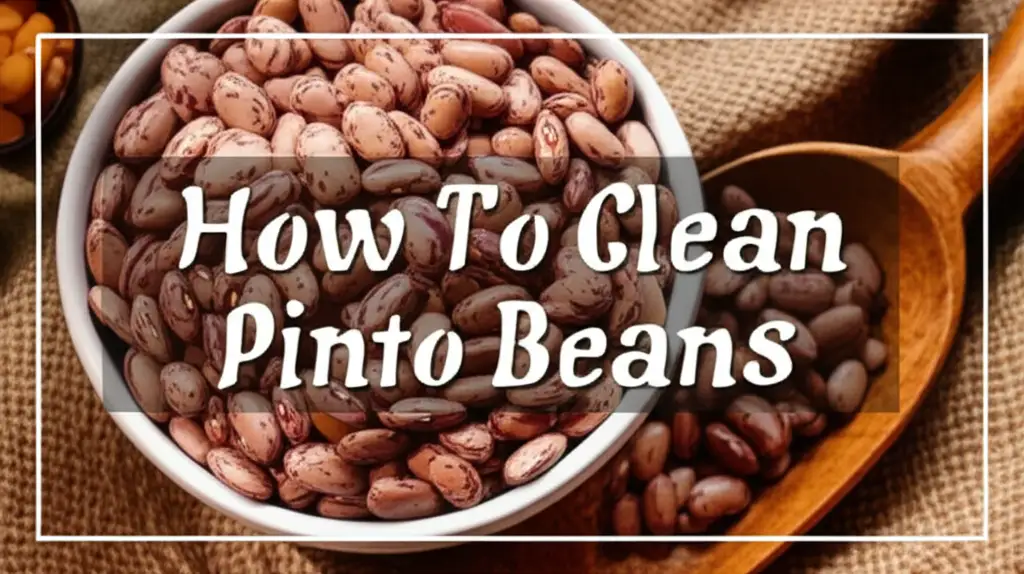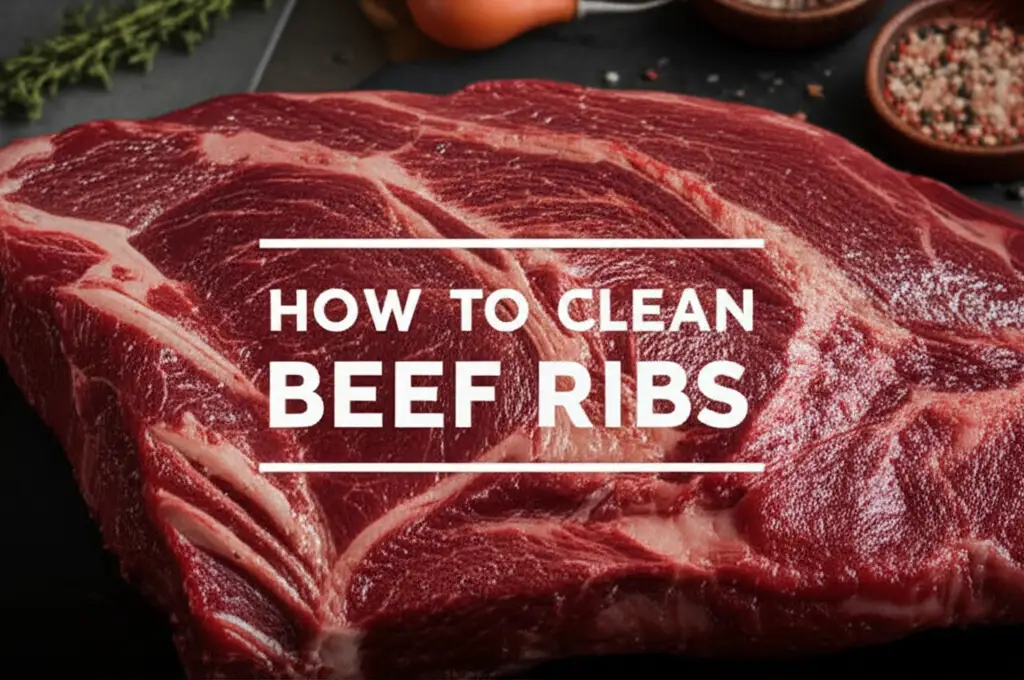· Food Preparation · 18 min read
How To Clean Pinto Beans

Perfecting Pinto Beans: How to Clean Them
Cleaning pinto beans before you cook them makes a big difference. It helps ensure your meals are safe and delicious. Many people overlook this basic step, thinking it is not important. However, taking a few minutes to clean beans removes unwanted items. It also helps improve their texture and cooking time. I always take this step, and I think you should too.
This article will show you simple ways to clean pinto beans. We will cover why cleaning matters, what tools you need, and the steps for sorting and rinsing. We will also look at soaking methods and how to handle common issues. By the end, you will know exactly how to get your pinto beans ready for any dish. This knowledge helps you create great meals with confidence.
Takeaway
Cleaning pinto beans is a simple, essential step for safe and tasty cooking.
- Always inspect dried beans for debris and spoiled pieces.
- Rinse beans thoroughly under cold, running water.
- Soaking helps reduce cooking time and improve digestion.
- Discard any broken or discolored beans.
How do you clean pinto beans?
To clean pinto beans, first spread them on a light-colored surface. Remove any small stones, dirt clods, or shriveled beans. Next, place the sorted beans in a colander and rinse them well under cool, running water until the water runs clear. This process prepares them for soaking or cooking.
Why Cleaning Pinto Beans Matters for Your Kitchen
Cleaning pinto beans is more than just a kitchen chore; it is a vital step for food safety and flavor. Many people buy dried beans and use them without proper cleaning. This is a mistake. Dried beans often come with unwanted items mixed in. These items can include small stones, dirt, or bits of plant material. Eating these things is not safe. Finding a stone in your food is also unpleasant.
Uncleaned beans can also affect your meal’s taste and texture. Dust and tiny debris can give a muddy flavor to your dish. Properly cleaned beans absorb water better. This leads to a more even cooking result. Your beans will have a creamy texture and rich flavor. I learned this lesson early in my cooking journey. My dishes improved greatly once I started cleaning beans carefully. It feels good to know my food is clean and ready.
Taking time to clean your beans shows care for your food. This care helps you make better meals. It is a small effort for a big reward. Clean beans cook more consistently. They also taste fresher. This step is a cornerstone of good cooking. You avoid bad surprises and enjoy your dish more. It makes all the difference in the final product.
Gathering Your Simple Cleaning Tools
You do not need fancy gadgets to clean pinto beans. The tools are probably already in your kitchen. This simplicity makes the cleaning process easy to start. My go-to items are always within reach. You can begin right away.
First, you need a large, flat surface. A baking sheet works well. A clean kitchen counter is also fine. The light color of the surface helps you see small debris. This step lets you spread out the beans in a single layer. Seeing everything clearly makes sorting easier. It helps you catch every tiny stone or piece of dirt.
Next, get a colander or a fine-mesh sieve. This tool is essential for rinsing. It lets water flow through while keeping the beans in place. Make sure the holes are small enough. You do not want your beans to slip through. A good rinse removes dust and any remaining loose particles. This is a very effective way to make sure the beans are completely clean.
Finally, you need clean, cool running water. Your kitchen faucet is perfect. The steady stream helps wash away impurities. You can also use a large bowl for soaking. Soaking is an optional step, but many people find it helpful. These simple items help you get your pinto beans ready. With these tools, you are set to begin cleaning your beans effectively.
The First Step: Inspecting and Sorting Pinto Beans
Inspecting and sorting dried pinto beans is the most important step in cleaning them. This is where you remove any harmful or undesirable elements. I always start here. It is like a treasure hunt, but instead of treasure, you are finding things to throw away. This process requires a little patience, but it is worth the effort.
To begin, pour your dried pinto beans onto a light-colored baking sheet or a clean kitchen counter. Spread them out into a single layer. This wide spread helps you see each bean clearly. It also lets you spot any foreign objects quickly. I often use a large white plate for smaller batches. The contrast helps a lot.
Carefully examine the beans. Look for small stones, dirt clods, or tiny sticks. Sometimes you might find dried husks or other plant bits. These things are common in bags of dried beans. Pick them out and discard them. You are protecting your teeth from unexpected crunch, and your meal from unwanted flavors. This is a very important part of the process.
Also, look for damaged or discolored beans. Some beans might be shriveled, broken, or have dark spots. These beans can affect the taste or texture of your dish. They might not cook evenly. Remove any beans that look unhealthy or different from the rest. This selection ensures that only good quality beans go into your meal. Taking this first step seriously sets you up for a great result.
What to Look For
When inspecting pinto beans, specific things need your attention. Knowing what to find makes the sorting process efficient. I have a mental checklist I go through. This helps me not miss anything important.
- Small Stones and Pebbles: These are the most common and dangerous items. They look like beans but are much harder. Finding one can chip a tooth. Run your fingers through the beans. You can often feel their hard edges.
- Dirt Clods: These are clumps of dried earth. They often blend in with the bean color. They crumble easily but can leave grit. Pick them out if you see them.
- Twigs and Stems: Small pieces of plant material from the harvesting process. These are harmless but unpleasant to eat.
- Shriveled or Wrinkled Beans: These beans are old or did not dry properly. They will not cook well. They stay hard and chewy. Remove them to ensure an even cook.
- Discolored or Moldy Beans: Look for beans with unusual dark spots, green patches, or white fuzz. These indicate spoilage. They can make you sick. Discard them immediately. You cannot clean mold off food effectively for consumption. It is always better to throw out anything suspicious.
- Broken Beans: Beans that are split or broken into pieces. They cook faster than whole beans. This can lead to some beans being mushy while others are still firm. It is best to remove them for consistent texture.
By focusing on these specific issues, you make sure your pinto beans are safe and ready. This careful inspection helps you prevent problems later. It guarantees a good cooking experience. You want your finished dish to be perfect.
Rinsing Pinto Beans Thoroughly
After sorting, the next critical step is rinsing your pinto beans. Rinsing removes dust, dirt, and any tiny particles that you might have missed during inspection. It also washes away any starchy residue from the bean’s surface. This residue can make the cooking water cloudy. I find that a good rinse makes my beans taste much cleaner.
To rinse, place the sorted pinto beans into a colander or a fine-mesh sieve. Hold the colander under cool, running water. Move the beans around with your hands or a spoon. Make sure the water touches all of the beans. The goal is to wash away any lingering surface grime. You might see the water turn cloudy at first. This is normal.
Continue rinsing until the water running through the colander appears clear. This usually takes a minute or two. Do not rush this step. Clear water means most of the surface impurities are gone. This step is like using a water filter to clean the incoming water. Just as you clean a water filter to remove impurities from your drinking water, you clean your beans to remove impurities from their surface. Cleaning your water filter ensures clean water. Rinsing your beans ensures clean beans.
Once the water is clear, shake the colander gently to drain excess water. You want the beans to be damp, but not sitting in a pool of water. They are now ready for the next step, which is usually soaking. Thorough rinsing makes a big difference in the final dish. It ensures a pure flavor and helps the beans cook better. This simple act prepares your beans for their best performance.
Best Rinsing Practices
Proper rinsing makes sure your beans are truly clean. There are a few small tricks that make this process even better. I use these tips every time I rinse beans. They help get the job done right.
First, use cold water. Cold water helps keep the bean structure firm. Hot water might start to cook them slightly or cause them to swell too quickly. A gentle, steady stream works best. You do not need a strong spray. A strong spray might break the beans.
Agitate the beans. Stir them with your hand or a large spoon while the water runs. This movement helps dislodge any dirt stuck to the bean surfaces. It ensures all sides of each bean get washed. Imagine trying to clean stains. You need to rub them. Similarly, with beans, agitation helps. If you were wondering how to clean stains, like on wood, you would apply friction and a cleaning agent. Learning how to clean stains on wood also involves thorough washing. This helps remove all unwanted material.
Rinse in batches if you have a very large amount of beans. Overfilling your colander can prevent thorough rinsing. The water cannot reach all the beans effectively. Smaller batches ensure every bean gets properly cleaned. This prevents problems later in cooking.
After rinsing, you can also give them a final quick visual check. Sometimes, a tiny bit of grit might still be there. This final check helps you catch it. A well-rinsed bean is a clean bean. This attention to detail leads to better results. It ensures your beans are ready for their next step.
To Soak or Not to Soak: Pre-Soaking Pinto Beans
Soaking pinto beans before cooking is a common practice, and it offers several benefits. While not strictly a “cleaning” step, it is a key part of preparing beans for cooking. Many cooks, including me, prefer to soak. It saves time and helps with digestion.
One main reason for soaking is to reduce cooking time. Dried beans are very hard. Soaking allows them to absorb water, making them softer. This means they cook faster on the stove or in a pressure cooker. Without soaking, beans can take much longer to become tender. This can throw off your meal timing. I always plan for soaking if I am short on cooking time.
Soaking also helps with digestion. Beans contain complex sugars called oligosaccharides. These sugars can cause gas and bloating for some people. Soaking helps break down these sugars. This makes the beans easier on your digestive system. It is a simple way to enjoy beans without discomfort. I find this especially helpful when serving beans to guests.
There are two main methods for soaking: overnight soaking and quick soaking. Each has its own advantages depending on your schedule. Choose the method that best fits your needs. Soaking is an extra step, but it is one that pays off. It makes for a more pleasant eating experience.
Overnight Soaking
Overnight soaking is the most traditional and simplest method for preparing pinto beans. It requires little effort once you start the process. This method gives beans plenty of time to absorb water. I often use this method when I plan my meals in advance. It takes away the rush.
After you have sorted and rinsed your pinto beans, place them in a large bowl. Add plenty of cold water. Use at least three times the amount of water as beans. For example, if you have one cup of beans, add three cups of water. The beans will expand as they soak. You need enough water to keep them fully submerged.
Cover the bowl. You can use a lid or plastic wrap. Place the bowl in the refrigerator. This is important, especially in warm climates, to prevent fermentation. Let the beans soak for at least 8 hours, or up to 12 hours. Some people even soak for up to 24 hours. The longer soak often leads to a creamier bean texture.
Before cooking, drain the soaking water. Rinse the beans one more time under cool, running water. The soaking water contains the dissolved oligosaccharides, so discarding it helps with digestion. This final rinse ensures the beans are completely ready for cooking. Overnight soaking is a reliable way to get perfectly tender beans.
Quick Soaking
Sometimes you do not have 8-12 hours for an overnight soak. This is where the quick soak method comes in handy. It speeds up the rehydration process significantly. I use this method when I decide to make beans at the last minute. It is a great time-saver.
First, sort and rinse your pinto beans as usual. Place them in a large pot. Add water to cover the beans by at least three inches. Make sure there is ample water. The beans will expand quickly.
Bring the water to a boil over high heat. Let the beans boil for 2-3 minutes. This short, intense heat starts the rehydration process quickly. After boiling, remove the pot from the heat. Cover the pot with a lid. Let the beans stand in the hot water for 1-2 hours. Do not lift the lid during this time. The trapped heat continues to soften the beans.
After the quick soak, drain the beans. Rinse them thoroughly under cool, running water. Just like with overnight soaking, discarding this water helps reduce gas-causing compounds. The beans are now plump and ready to cook. They will cook in about the same amount of time as beans soaked overnight. This method gives you flexibility. It means you can still enjoy beans even with less planning.
Addressing Common Cleaning Concerns
Even after sorting and rinsing, you might notice some issues with your pinto beans. Knowing how to handle these common concerns ensures your beans are truly ready for cooking. It helps you prevent problems that affect your final dish. I have encountered these situations many times.
One common concern is finding many broken beans. Despite your best efforts during sorting, some beans might be cracked. These broken pieces tend to cook faster than whole beans. They can become mushy while the whole beans are still firm. If you have many broken beans, you can try to pick them out. However, for a few broken pieces, it is generally okay to leave them in. Just know your final dish might have varied textures. For most recipes, a small amount of variation is not a big deal.
Another issue is persistent floating debris during rinsing or soaking. Sometimes, tiny bits of husk or very small, lightweight beans will float to the surface. This is normal. These are usually harmless. You can simply skim them off the surface with a spoon and discard them. This action is similar to removing sediment. If you need to clean sediment out of a well, you use tools to remove suspended particles. Learning how to clean sediment out of a well helps ensure clean water. Skimming floating debris from beans helps ensure clean beans.
Sometimes, after soaking, you might notice a few beans are still shriveled or look different. These beans did not rehydrate properly. It is best to remove them. They will likely remain hard after cooking. Discarding them helps ensure a uniform texture in your cooked beans. These small adjustments make a big difference in your finished dish. You will feel good about serving them.
Drying and Storing Clean Pinto Beans
After you clean your pinto beans, you might not want to cook them right away. Proper drying and storage are important if you plan to keep them for later. This step prevents spoilage and keeps your beans fresh. I always make sure my beans are dry before storage.
If you have soaked your beans, they are wet. Spread them out on a clean kitchen towel or paper towels. Let them air dry for a few hours. You can also gently pat them dry. The goal is to remove all surface moisture. Moisture can lead to mold or bacterial growth. This is a crucial step for preventing spoilage.
Once the beans are completely dry, store them in an airtight container. A glass jar with a tight lid or a heavy-duty plastic container works well. Make sure the container is clean and dry before you use it. Any moisture inside the container can spoil the beans. You are trying to create an environment where the beans stay in good condition.
Store the container in a cool, dark, and dry place. A pantry or a cupboard away from heat sources is ideal. Avoid storing beans in direct sunlight or near appliances that produce heat. Heat and light can degrade the quality of the beans over time. Cleaned and dried pinto beans can last for several months or even up to a year in proper storage. They will be ready whenever you decide to cook. This careful storage helps you always have fresh beans on hand.
Frequently Asked Questions
What happens if I don’t clean my pinto beans?
If you do not clean pinto beans, you risk cooking and eating small stones, dirt, or other debris. This can be unpleasant and may even chip a tooth. Uncleaned beans also carry surface dust and impurities. These can affect the flavor and texture of your final dish. Proper cleaning is a simple step to ensure food safety and quality.
Can I clean pinto beans in a colander only?
A colander is excellent for rinsing pinto beans. However, the most vital part of cleaning is the initial inspection and sorting. This step involves spreading the beans on a flat surface to visually identify and remove stones, dirt, and bad beans. The colander then helps wash away surface dust, but it cannot remove hidden debris.
Do I need to soak pinto beans before cooking?
Soaking pinto beans is not strictly required, but it is highly recommended. Soaking significantly reduces cooking time. It also helps break down complex sugars that can cause gas, making beans easier to digest for many people. You can choose between an overnight soak or a quick soak method depending on your schedule.
How long can cleaned pinto beans be stored?
Cleaned and thoroughly dried pinto beans can be stored in an airtight container in a cool, dark, and dry place for several months to a year. If you have soaked them, they need to be cooked within a day or two and stored in the refrigerator. Do not store soaked beans for longer periods.
What causes floating beans during soaking?
Beans that float during soaking are usually dried-out, hollow, or imperfect. They may not rehydrate properly. While a few floating beans are normal, a large number might indicate an older batch. It is best to discard these floating beans as they will likely remain hard or have an undesirable texture after cooking.
Can moldy pinto beans be cleaned and used?
No, you should never try to clean and use moldy pinto beans. Once mold appears on dried beans, it means they have been stored incorrectly or have absorbed too much moisture. Mold indicates bacterial growth that cannot be simply washed away. It is always safest to discard any beans showing signs of mold or unusual discoloration.
Conclusion
Cleaning pinto beans is a foundational step in preparing them for any recipe. It is a simple process that guarantees a better-tasting, safer, and more enjoyable meal. You start by carefully inspecting and sorting the beans. This removes unwanted items like stones and dirt. Next, you rinse the beans thoroughly under cool, running water. This washes away surface dust and loose particles. Soaking, whether overnight or quick, prepares the beans for faster cooking and better digestion.
By following these steps, you take control of your food preparation. You ensure that only the best quality beans make it into your dishes. This small effort makes a big difference in the final outcome. So, the next time you get ready to cook pinto beans, remember these cleaning methods. Your taste buds and your health will thank you. Get ready to enjoy delicious, perfectly prepared pinto beans in all your favorite recipes!
- pinto beans
- bean cleaning
- cooking tips
- food safety




